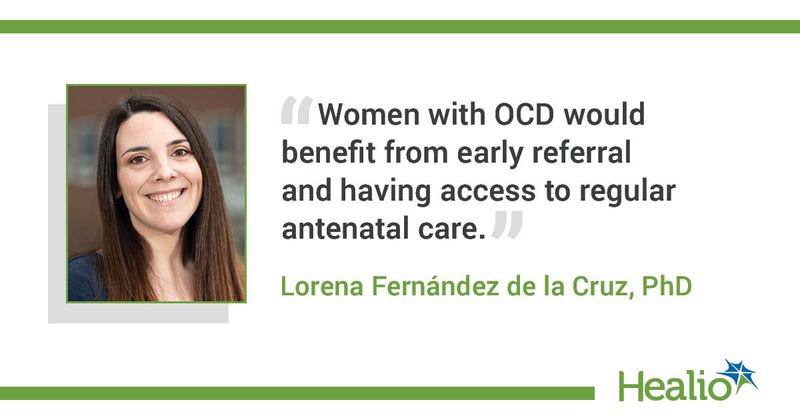Maternal OCD linked to adverse pregnancy, delivery, neonatal outcomes
Key takeaways:
- Women with OCD had increased risks for adverse pregnancy, delivery and neonatal outcomes vs. women without.
- Serotonin reuptake inhibitor use during pregnancy also increased risks for several adverse outcomes.
Maternal obsessive-compulsive disorder was associated with increased adverse pregnancy, delivery and neonatal outcomes, according to findings from two cohort studies published in JAMA Network Open.
“We believe that women with obsessive-compulsive disorder (OCD) would benefit from early referral in pregnancy and having access to regular antenatal care with the obstetric care team and also the physicians that routinely take care of their mental health symptoms,” Lorena Fernández de la Cruz, PhD, principal researcher at the Centre for Psychiatry Research in the department of clinical neuroscience at Karolinska Institutet, Stockholm, told Healio. “Clinicians should work together to reduce these risks, when possible. For example, preeclampsia, for which we observed an increased risk for women with OCD in our study, can be avoided if a good monitoring during pregnancy is in place.”

Fernández de la Cruz and colleagues conducted two register-based cohort studies in Sweden and British Columbia, Canada. These studies included all singleton births at 22 weeks or more gestation. The Swedish cohort included births from 1999 to 2019, and the British Columbia cohort included births from April 2000 to December 2019. Researchers examined maternal OCD diagnosis recorded before childbirth and the use of serotonin reuptake inhibitors (SRIs) during pregnancy.
Researchers assessed pregnancy and delivery outcomes including gestational diabetes, preeclampsia, maternal infection, antepartum hemorrhage or placental abruption, premature membrane rupture, labor induction, mode of delivery and postpartum hemorrhage. Neonatal outcomes included perinatal death, preterm birth, small for gestational age, low birth weight, low 5-minute Apgar score, neonatal hypoglycemia, neonatal jaundice, neonatal respiratory distress, neonatal infections and congenital malformations.
The Swedish cohort included 8,312 pregnancies among women with OCD that were compared with 2,137,348 pregnancies among unexposed women. In this cohort, maternal OCD was associated with increased risks for gestational diabetes (adjusted RR = 1.4; 95% CI, 1.19-1.65), elective cesarean delivery (aRR = 1.39; 95% CI, 1.3-1.49), preeclampsia (aRR = 1.14; 95% CI, 1.01-1.29), labor induction (aRR = 1.12; 95% CI, 1.06-1.18), emergency cesarean delivery (aRR = 1.16; 95% CI, 1.08-1.25) and postpartum hemorrhage (aRR = 1.13; 95% CI, 1.04-1.22).
The British Columbia cohort included 2,341 pregnancies among women with OCD that were compared with 821,759 pregnancies among unexposed women. In this cohort, maternal OCD was associated with significantly higher risks for emergency cesarean delivery (aRR = 1.15; 95% CI, 1.01-1.31) and antepartum hemorrhage or placental abruption (aRR = 1.48; 95% CI, 1.03-2.14).
In the Swedish and British Columbia cohorts, women with OCD delivered children who were at elevated risks for low 5-minute Apgar score (Sweden: aRR = 1.62; 95% CI, 1.42-1.85; British Columbia: aRR = 2.3; 95% CI, 1.74-3.04), low birth weight (Sweden: aRR = 1.28; 95% CI, 1.14-1.44; British Columbia: aRR = 1.4; 95% CI, 1.07-1.82) and neonatal respiratory distress (Sweden: aRR = 1.63; 95% CI, 1.49-1.79; British Columbia: aRR = 1.47; 95% CI, 1.2-1.8). Women with OCD also had a higher risk for preterm birth in the Swedish (aRR = 1.33; 95% CI, 1.21-1.45) and British Columbia (aRR = 1.58; 95% CI, 1.32-1.87) cohorts.
Overall, 37.2% of women with OCD were taking SRIs in the Swedish cohort, and 81% were taking SRIs in the British Columbia cohort. Women with OCD who took SRIs during pregnancy had increased risks for several pregnancy, delivery and neonatal outcomes compared with women not taking SRIs. Researchers also observed increased risks for these outcomes among women with OCD not taking SRIs compared with women without OCD.
According to Fernández de la Cruz, women with OCD and their health care providers should have all available information and assess risks and benefits of treatment while monitoring any pharmacologic treatment changes and, if indicated and available, other therapeutic options, such as cognitive-behavior therapy, should be explored.
“Our study shows that mothers with OCD have an increased risk of adverse pregnancy, delivery, and neonatal outcomes, compared with mothers that do not have OCD,” Fernández de la Cruz said. “This seems to be more severe in women that take medication for their OCD. However, these women may also be the most severe group, so we cannot tell if the increased risk is due to the medication or to the disorder being more pervasive. More research on this is needed.”
For more information:
Lorena Fernández de la Cruz, PhD, can be reached at lorena.fernandez.de.la.crus@ki.se.
